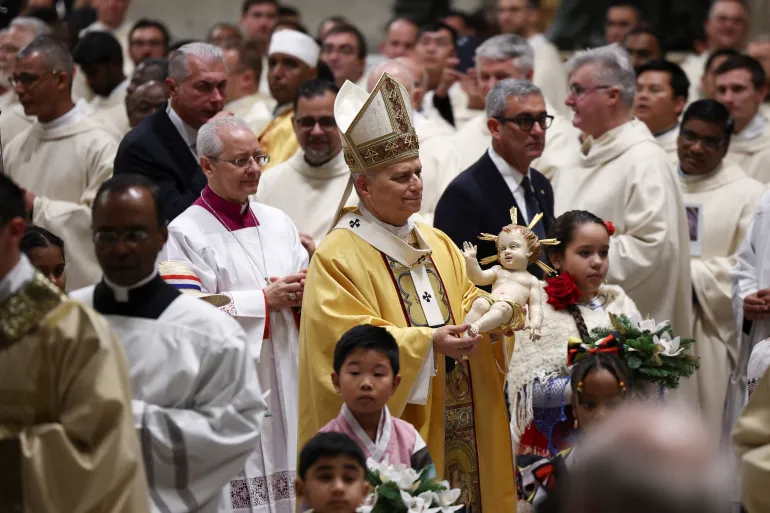Pope Leo laments suffering of Gaza Palestinians in first Christmas sermon | Religion News
Pope Leo has decried conditions for Palestinians in Gaza in his first Christmas sermon as pontiff, in an unusually direct appeal during what is normally a solemn, spiritual service on the day Christians across the globe celebrate the birth of Jesus Christ.
Leo, the first American pope, said on Thursday that the story of Jesus being born in a stable showed that God had “pitched his fragile tent” among the people of the world.
Recommended Stories
list of 3 itemsend of list
“How, then, can we not think of the tents in Gaza, exposed for weeks to rain, wind and cold?” he asked.
Leo, celebrating his first Christmas after being elected in May by the world’s cardinals to succeed the late Pope Francis, has a quieter, more diplomatic style than his predecessor and usually refrains from making political references in his sermons.
But the new pope has also lamented the conditions for Palestinians in Gaza several times recently and told journalists last month that the only solution in the decades-long conflict between Israel and Palestine must include a Palestinian state.
Israel and Hamas agreed to a ceasefire in October after two years of intense bombardment and military operations in Gaza, but humanitarian agencies say there is still too little aid getting into the largely destroyed Strip, where nearly the entire population is homeless after being displaced by Israeli attacks.
In Thursday’s service with thousands in St Peter’s Basilica, Leo also lamented conditions for the homeless across the globe and the destruction caused by the wars roiling the world.
“Fragile is the flesh of defenceless populations, tried by so many wars, ongoing or concluded, leaving behind rubble and open wounds,” said the pope.
“Fragile are the minds and lives of young people forced to take up arms, who on the front lines feel the senselessness of what is asked of them and the falsehoods that fill the pompous speeches of those who send them to their deaths,” he added.
In a later appeal during the “Urbi et Orbi” (to the city and the world) message and blessing given by the pope at Christmas and Easter, Leo called for an end to all global wars, lamenting conflicts, political, social or military, in Ukraine, Sudan, Mali, Myanmar, and Thailand and Cambodia, among others.

‘The wounds are deep’
Ahead of the pope’s mass, in Bethlehem in the occupied West Bank, the Christian community began celebrating its first festive Christmas in more than two years, as the Palestinian city and biblical birthplace of Jesus emerges from the shadow of Israel’s genocidal war on Gaza.
Throughout the war, a sombre tone had marked Christmases in Bethlehem. But celebrations returned on Wednesday with parades and music. Hundreds of worshippers also gathered for mass at the Church of the Nativity on Wednesday night.
With pews filled long before midnight, many stood or sat on the floor for the traditional mass to usher in Christmas Day.
At 11:15 pm (21:15 GMT), organ music rang out as a procession of dozens of clergymen entered, followed by Jerusalem’s Latin Patriarch Pierbattista Pizzaballa, who blessed the crowd with signs of the cross.
In his homily, Pizzaballa urged peace, hope and rebirth, saying the Nativity story still held relevance in the turbulence of modern times.
He also spoke of his visit to Gaza over the weekend, where he said “suffering is still present” despite the ceasefire. In the Strip, hundreds of thousands of people face a bleak winter in makeshift tents.
“The wounds are deep, yet I have to say, here too, there too, their proclamation of Christmas resounds,” Pizzaballa said. “When I met them, I was struck by their strength and desire to start over.”
In Bethlehem, hundreds also took part in the parade down the narrow Star Street on Wednesday, while a dense crowd massed in the square. As darkness fell, multi-coloured lights shone over Manger Square and a towering Christmas tree glittered next to the Church of the Nativity.
The basilica dates back to the fourth century and was built on top of a grotto where Christians believe Jesus was born more than 2,000 years ago.
Bethlehem residents hoped the return of Christmas festivities would breathe life back into the city.
